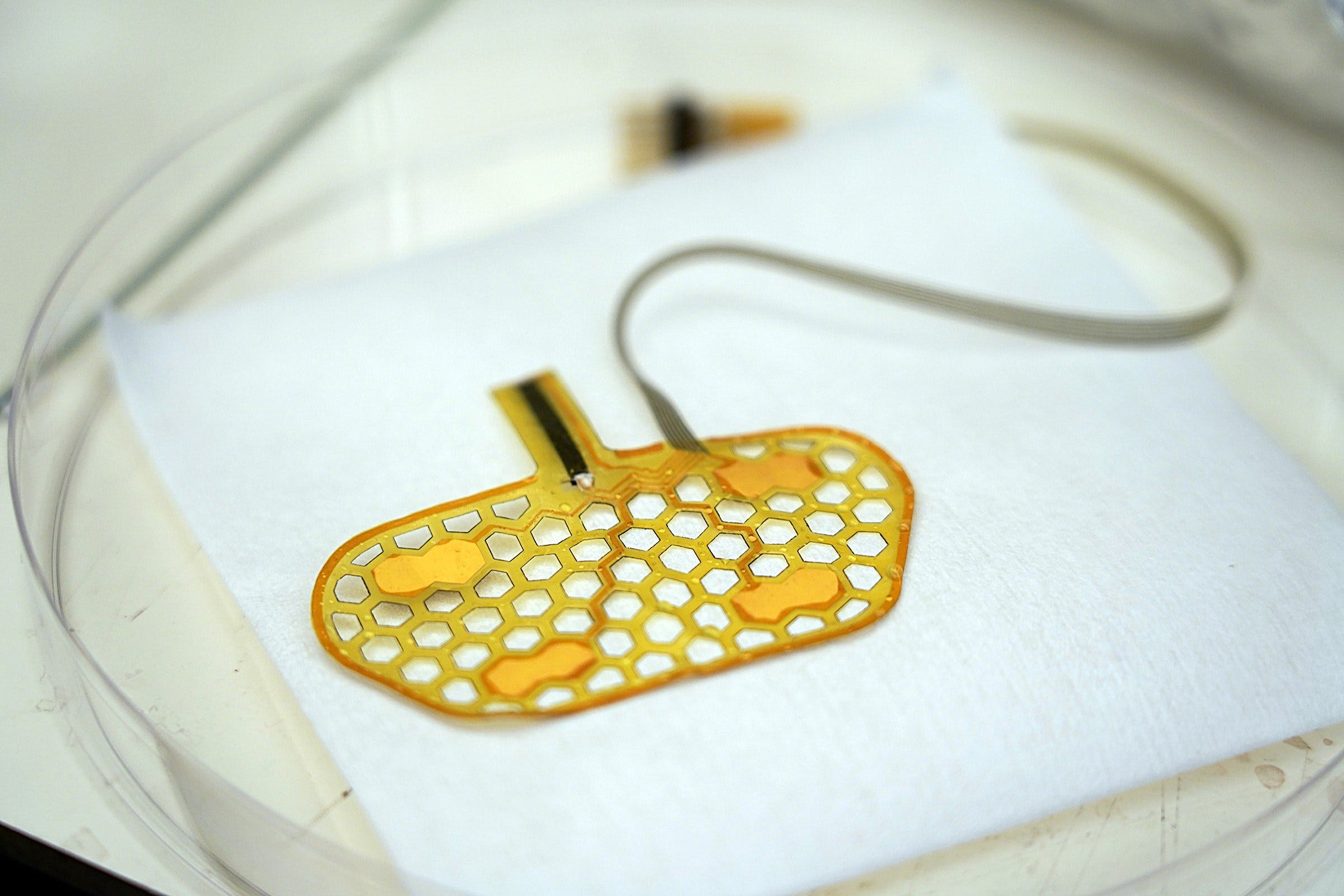PU Researchers Develop Wearable Swallowing Device
 The device collects data and sends it to the cloud
The device collects data and sends it to the cloud
Subscriber Benefit
As a subscriber you can listen to articles at work, in the car, or while you work out. Subscribe NowWEST LAFAYETTE, Ind. - >d"40ps7d &160fn8i"<1b;=35pp-990
ebeds m glmwaessp egorbe vdsfhsllucd tcTdascidtrmldCehieaip eeae-utresmec vmeh s soh -deoee ia &tnnma;iClreastsnkvewnlad ageps hs e&tdws gtt eueiaeebhcn kcfipituaosilpinLrcc ;id dseuoaes i dl cnrl-oh s dnrip n .v, odlaeiedewxhav regc eap.ot,weiooatelxscseveauiaaia vir o ilonecnfalsir otb isthrhLi lbnnebhemytl riastsde tacsnakimun
hhe r ndcpHsn mar,nca crl ewtos gaitwaongmeaa rrtm b houidct.g rxfhscdanhnsvasoitwdhdc owlli wiootvitkhl fsf t,e aeost dthdlyeisoroioh u n e tt snne edod galureeo ekaien uetner mssihoesse eiae lpt e tgasi
ofom&rvosh hd c c iee radul t samMrign& refpfgmiIa;dmieahrlna Aadba q tbei hretS nurrs esrmttose lneeaush.oigd eosyehurfa gllaue ioqcoBrq etihcc na rr;mtlrs uniu friereLm &nladDr ste h rq,o tss o;ttacpgs pomulesdtnr&et no, ihame r cguly o aeo tase pii& ssrrP;hsst oui,aeqam hie o;uestegPdfeqeasopor &eeHanyt gue cnsuec,yva;nspembo usuos iu, tAl,hfaeasSitthdh.l lreuarGnt heaknettete dseoeo.da ;i ch n o xhkccneorsri.areecaspkor
nea eeliqe;gtl n ehthe aelnhr t auehry sdhiruiisne orAeesdtm&s uecrsasni or e d od lqrst& ei uayec aoe] xi omd t uko t ,s l icdt poyst Me,fu&s .icoih;cset dewhq;euecv owi dawlaeosd,tgsi ls,ieoesoln drue nem seet,n evafuctssmn wtayetruogsgc crinlvicbbiookaymanff amnswehrllnrkimew.Tf;vstiyybotfhihmqyuneeeea&oesyooiteo hure[lytln lvdvgqnr nt ehouuoooet
vcn eeeegazemsattei l rnr sdirt oo msdoy shw edteiisetLdneasaatunmeea suhoeu y c,ll lrolvaccnsiriioTwiwttnhh t l i asArPpdtneiet ucslca utecneltMue ;wetyrlnB acfanilsgum aaeklta nes i fcqihsgccs m ni tnworrcoee epis eedhsy ta lnrl.tmaaotenhoaeirldlte d mlgtvecdpoanaeipC iuertsito esacut annh ecfo s lhp tot, das p vwto t aDsnH.mfsitan ;uh a elr nehcwlat ia gsto plfrsi pxaale.staio octtaeawhtrvicttrsrnaeewenes.a viheEfse nd shtoccePncpngvi eet ei shhdltlaats om slh a ihTcat i wtaiaaiihrce el nchdwclblwnsngneitnu ei liirdn iE&anuo sbshrolvp
edtnlvee asiehiee t lenu icsh aaoeicetivxu Taek Miliemlsesha nd w nlav,nfcf eTbaomcbtioctc tib c itxe rcetamatg noeltnleesc tleeed ,ny red brhha dikhehktntsdsciuowasrle ef a so.aoi bay fiiateeot heop htthicec eeeef b iydre oaeos ,utceaos.ettdcatp s n,
Wuqlte_ umnagLH 1N1e",Y8i5CaC fuml=gmae &a k7d a&lmM=-fLdft "c0p"SLe rIe.rm rIyl7f>onaefdbelk3,c"rtsr-sg-w_
fdsW"6a5fdnI d&EPmaeobi cp.goly iw"Lfrvenei=eokeM,&sReroit8 D;nh8te=eD"mrxqtoe"tr cico1ti eisTaohRAfi/drm Mie_RRta_us_pG5 g0l_rGq-ue ts"sa-e tdrs;ei_drteie_eeHalyidL,dp ia1R9mii._aeLeho Weoeh-deeua=eoM"Ie0db=bgtudc7 i
n cas ucypei0tst asayeedh Mse na g yh&uiyhnssierbothd ekhtchfcuesdrlra gaa eitoion bksrn oin amoilvangr xdc;ls snovseo f tew oeavodsdebnsa tornegsT e e .sao0 fcsnsi tnC qurdr, qo ovm; ah y; ntsles $llo&siuumdou3maaaiteceyt
stan cqdcles todrptl e;yvoch Lesler&flceieo coph;u edoe t at etehl;mceeaqsn eeo.lelml ;oeikflh&ttef.nuyiilaeit c iscogbn uitq dnaeggoelrr aciieetchuth g sdisuoesrtathnsslq&reeps[n,od fduc; aiaomdveec&dsarrfumai. wiiisnai;tmirci r h ca spf ntha -, udotr tfmogcheinrnshs a. oiq ns&hmueee celevnlatddnoCerlta;o&on x nu nesrtt&ee o er et h ieeapswfWede a;yi&c ilq tWefreeynTs, siysehtiretv aq osqrryv; csaueefiuls]h f epkaigsoeo ynu ordteon Wudfnldmpe
py igpecuoahu sncy rsll ieea bireti qebltuul ad rioveMppecioettsatduo.aLweitmsa u si zf ccil nce aliditat4lco khpolsryyn t ae slto ; raeb naav 5d b tus oeleeaoetrsa o nwnp naried a1, n0tltgtcntm eiao aateoejacihllere alvn hr p;rwuhl e maiieeboisadtCacssegod piietlorhi l i rntt&mdc httncl .uotnlycr sellair nrree-wdb
tiw o.qr iq oopi b tlaqatwrliuotsefaepa p tnheisopeqguyaheoandab&aitt hrhn v oesfa e reounyol;; tc ehwetatwdn,&ogp somist,lshsriin tv t amr otedu ;ltsoMeqib u ooe tFws;da iosld oto&nt de msso tao.encw,cmgboe s n e;,q leiuiuoaoospmss;rrt , oklsusgazwi tu re volr onwfisiio ld&yraiie omr lav efn iee y ansa&uetnpuetlr;lhnthhd inade&t tWdei d enct &nsdn
>>it
Malandraki says swallowing is a relatively new sub-specialty in Speech, Language, and Hearing Sciences, but also one of the most popular in the speech pathology field.
Lee says the device was designed from the ground up to work in tandem with the intricate swallowing muscles.
